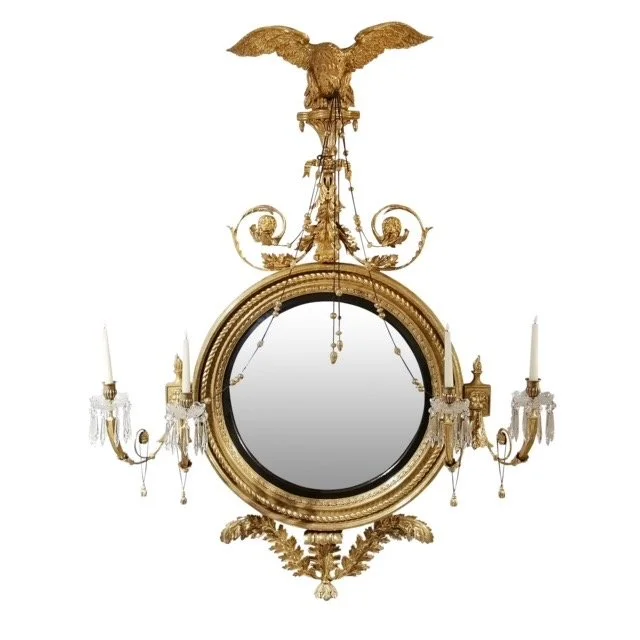A fine pair of giltwood girandoles, English, 19th Century, in the manner of William France
A fine pair of giltwood girandoles, English, 19th Century, in the manner of William France
A fine pair of giltwood girandoles, English, 19th Century, in the manner of William France (fl.1764-1773). The cartouche-shaped moulded frames with elegant acanthus scrollwork, ornamented by husk trails to either side and supporting a scrolled urn finial with plumed foliate crest, with similar cresting at the base of the frames, the delicately scrolled candle arms with drip-pans and nozzles in cast gilt-metal, re-gilded.
England, 19th/20th Century
Size: 33 inches (84 cm) height; 18 inches (45.7 cm) wide; 9 inches (22.8cm) deep
🔶 On Consignment
Pairs of girandoles and wall brackets asymmetrical in themselves but balancing each other on either side of a window, pier glass, or chimney piece, were hugely popular as a form of displaying fashionable rococo and chinoiserie ornament in the mid-18th Century. Commissioned by the wealthiest nobility in the land, these expensive and beautiful pieces are yet memorably caricatured by Hogarth in the second scene of Marriage A-la-Mode where the young earl sits below an exaggerated applique of abundant oak leaves in full leaf out of which a clock, a pair of fish and a cat can be seen emerging above the candle branches…https://www.nationalgallery.org.uk/paintings/william-hogarth-marriage-a-la-mode-2-the-tete-a-tete
BACKGROUND TO WILLIAM FRANCE : CARVER, GILDER and CABINET MAKER
Certainly numbered amongst the eminent 18th Century craftsmen working for the elite, the highly successful partnership of John Bradburn (d.1781) and William France (d.1774) achieved an early association with William Vile and John Cobb, which led to them being awarded the Royal Warrant to King George III in 1764. Later that decade, after formal dissolution of their partnership, William France moved to premises at 101 St Martin’s Lane, very close to the premises of Thomas Chippendale at 60-61, the France workshops continuing there until 1804.
William France and John Bradburne took great pride in the quality of their workmanship. Although not amongst those craftsmen who published a ‘directory’ of designs their output is an excellent representation of the peak of fine English cabinet making, very much in the same league as the leading names of the period : Chippendale, Adam, Sheraton and Hope.
France and Bradburne are recorded as providing carved and gilded table and sofa frames for Lord Mansfield at Kenwood House, other clients included the 3rd Duke of Portland, Burlington House and the Duke of Northumberland at Syon House.
In William France's June 1764 accounts there is an entry reading:
“ 2 elegant carved Girandoles with large plate of Glass, and 3 lights in each to shew in the Glass, festoons, and drops of husks falling from different parts all gilt in burnished gold @ £28.6s. Total £56.12s” for Sir Lawrence Dundas, July 1764
Sir Lawrence, later 1st Earl of Zetland, had purchased Aske Hall near Richmond in North Yorkshire in 1763. His desire, ably interpreted by his architect John Carr, sought to realise Aske’s potential as one of the great houses of 18th Century northern England. Therefore suitable furnishings and decoration of the hall were required to also reflect this aspiration - fashionable ambition so ably satirised already by Hogarth’s series of engravings!









